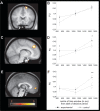Synchronization of medial temporal lobe and prefrontal rhythms in human decision making
- PMID: 23303925
- PMCID: PMC3562870
- DOI: 10.1523/JNEUROSCI.2573-12.2013
Synchronization of medial temporal lobe and prefrontal rhythms in human decision making
Abstract
Optimal decision making requires that we integrate mnemonic information regarding previous decisions with value signals that entail likely rewards and punishments. The fact that memory and value signals appear to be coded by segregated brain regions, the hippocampus in the case of memory and sectors of prefrontal cortex in the case of value, raises the question as to how they are integrated during human decision making. Using magnetoencephalography to study healthy human participants, we show increased theta oscillations over frontal and temporal sensors during nonspatial decisions based on memories from previous trials. Using source reconstruction we found that the medial temporal lobe (MTL), in a location compatible with the anterior hippocampus, and the anterior cingulate cortex in the medial wall of the frontal lobe are the source of this increased theta power. Moreover, we observed a correlation between theta power in the MTL source and behavioral performance in decision making, supporting a role for MTL theta oscillations in decision-making performance. These MTL theta oscillations were synchronized with several prefrontal sources, including lateral superior frontal gyrus, dorsal anterior cingulate gyrus, and medial frontopolar cortex. There was no relationship between the strength of synchronization and the expected value of choices. Our results indicate a mnemonic guidance of human decision making, beyond anticipation of expected reward, is supported by hippocampal-prefrontal theta synchronization.
Figures





Similar articles
-
Spatial Mnemonic Encoding: Theta Power Decreases and Medial Temporal Lobe BOLD Increases Co-Occur during the Usage of the Method of Loci.eNeuro. 2017 Jan 10;3(6):ENEURO.0184-16.2016. doi: 10.1523/ENEURO.0184-16.2016. eCollection 2016 Nov-Dec. eNeuro. 2017. PMID: 28101523 Free PMC article.
-
Hippocampal-Prefrontal Theta Oscillations Support Memory Integration.Curr Biol. 2016 Feb 22;26(4):450-7. doi: 10.1016/j.cub.2015.12.048. Epub 2016 Jan 28. Curr Biol. 2016. PMID: 26832442
-
Theta Oscillations Through Hippocampal/Prefrontal Pathway: Importance in Cognitive Performances.Brain Connect. 2020 May;10(4):157-169. doi: 10.1089/brain.2019.0733. Epub 2020 May 7. Brain Connect. 2020. PMID: 32264690 Review.
-
Adaptive closed-loop modulation of cortical theta oscillations: Insights into the neural dynamics of navigational decision-making.Brain Stimul. 2024 Sep-Oct;17(5):1101-1118. doi: 10.1016/j.brs.2024.09.005. Epub 2024 Sep 12. Brain Stimul. 2024. PMID: 39277130
-
Reward-dependent learning in neuronal networks for planning and decision making.Prog Brain Res. 2000;126:217-29. doi: 10.1016/S0079-6123(00)26016-0. Prog Brain Res. 2000. PMID: 11105649 Review.
Cited by
-
Fast Sequences of Non-spatial State Representations in Humans.Neuron. 2016 Jul 6;91(1):194-204. doi: 10.1016/j.neuron.2016.05.028. Epub 2016 Jun 16. Neuron. 2016. PMID: 27321922 Free PMC article.
-
Coordinated within-trial dynamics of low-frequency neural rhythms controls evidence accumulation.J Neurosci. 2014 Jun 18;34(25):8519-28. doi: 10.1523/JNEUROSCI.3801-13.2014. J Neurosci. 2014. PMID: 24948807 Free PMC article. Clinical Trial.
-
Asymmetric Frequency-Specific Feedforward and Feedback Information Flow between Hippocampus and Prefrontal Cortex during Verbal Memory Encoding and Recall.J Neurosci. 2021 Oct 6;41(40):8427-8440. doi: 10.1523/JNEUROSCI.0802-21.2021. Epub 2021 Aug 25. J Neurosci. 2021. PMID: 34433632 Free PMC article.
-
The Interplay of Hippocampus and Ventromedial Prefrontal Cortex in Memory-Based Decision Making.Brain Sci. 2016 Dec 29;7(1):4. doi: 10.3390/brainsci7010004. Brain Sci. 2016. PMID: 28036071 Free PMC article. Review.
-
Dissecting the Function of Hippocampal Oscillations in a Human Anxiety Model.J Neurosci. 2017 Jul 19;37(29):6869-6876. doi: 10.1523/JNEUROSCI.1834-16.2017. Epub 2017 Jun 16. J Neurosci. 2017. PMID: 28626018 Free PMC article. Clinical Trial.
References
-
- Attal Y, Bhattacharjee M, Yelnik J, Cottereau B, Lefèvre J, Okada Y, Bardinet E, Chupin M, Baillet S. Modeling and detecting deep brain activity with MEG and EEG. Conf Proc IEEE Eng Med Biol Soc. 2007;2007:4937–4940. - PubMed
-
- Benchenane K, Peyrache A, Khamassi M, Tierney PL, Gioanni Y, Battaglia FP, Wiener SI. Coherent theta oscillations and reorganization of spike timing in the hippocampal-prefrontal network upon learning. Neuron. 2010;66:921–936. - PubMed
-
- Boorman ED, Behrens TE, Woolrich MW, Rushworth MF. How green is the grass on the other side? Frontopolar cortex and the evidence in favor of alternative courses of action. Neuron. 2009;62:733–743. - PubMed
Publication types
MeSH terms
Grants and funding
LinkOut - more resources
Full Text Sources
Other Literature Sources
